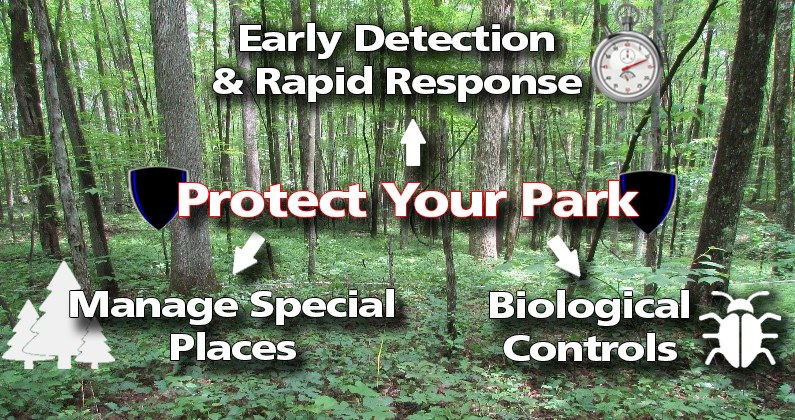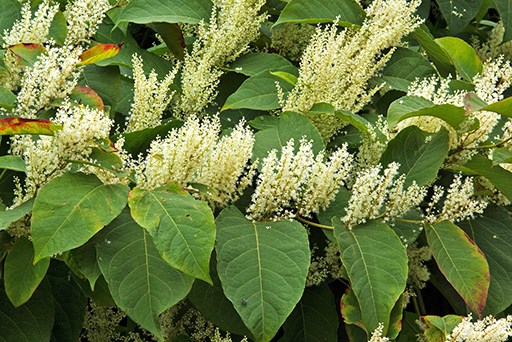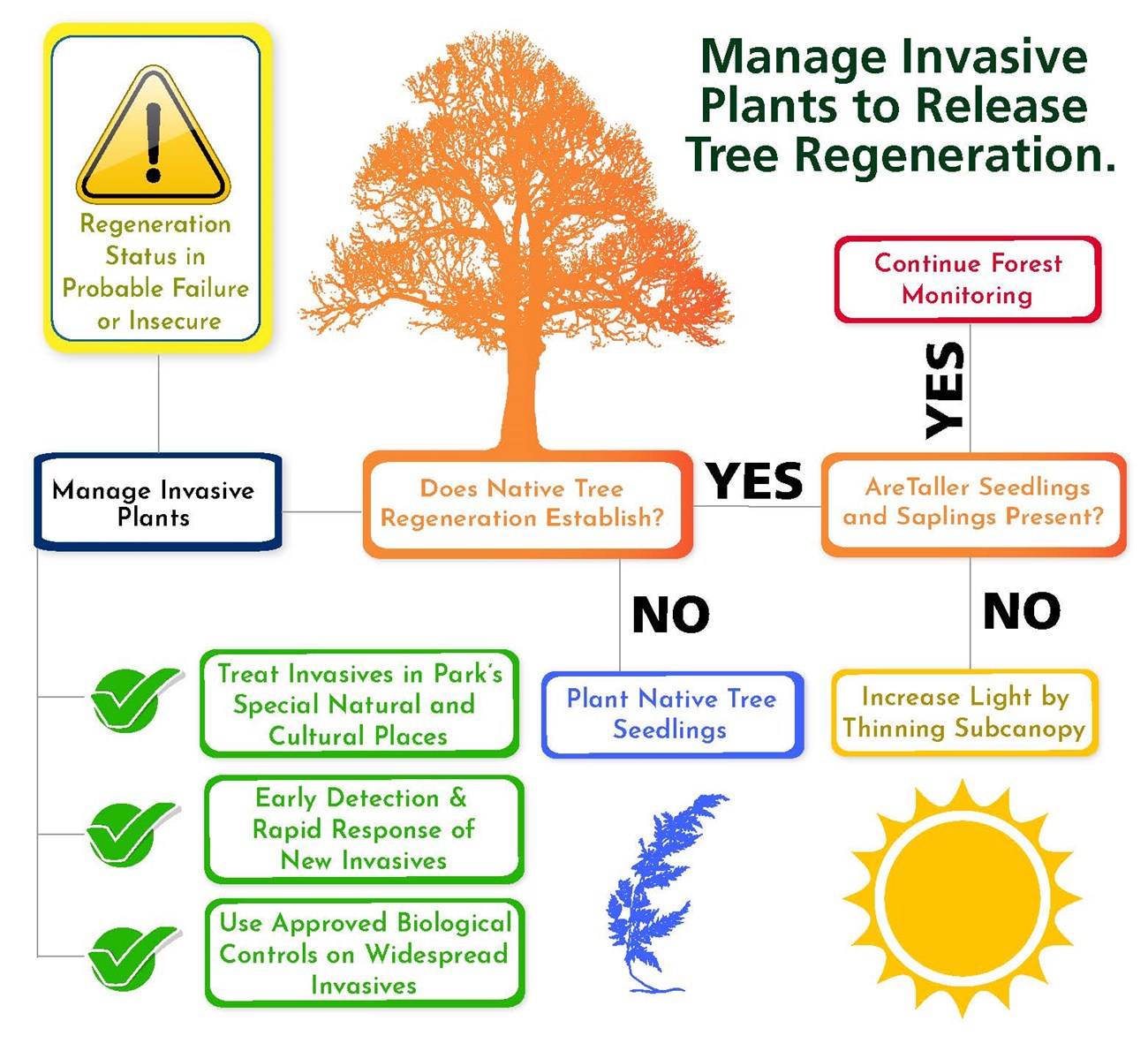Part of a series of articles titled Managing Resilient Forests Initiative for Eastern National Parks.
Article
Resilient Forests Initiative - Managing Invasive Plants & Pests
Managing invasive plants and responding to forest pests sustains resilient forests.
Park forests are threatened by invasive plants and pests. Strategically tackling invasive plants to protect park’s highest priority natural resources and planning around forest pests and pathogens are important actions in managing resilient forests.Invasive plants
A recent study from NPS Inventory and Monitoring Networks (I&M) showed that invasive plant species are expanding in eastern parks, and provided more information on how invasive species are changing (NPS only).
With help from expert Invasive Plant Management Teams (IPMT), park managers can address invasive plants through three different strategies:


Tom Potterfield
For invasive plants that are already widespread throughout a park, biological controls (also known as biocontrols) are often the only realistic management option. Biocontrols are usually host-specific insects or pathogens that feed only on one particular invasive plant. The biocontrols weaken the target invasive plant, limiting its spread and its ability to displace nearby native plants. The use of biocontrols is strictly regulated and guided by federal and state laws, an International Code of Best Practices, and specific protocols that are all designed to ensure their safety and effectiveness. For more information on how parks can use biocontrols, contact Mid-Atlantic IPMT Supervisory Biologist Casey Reese.
It can often be a challenge for park staff to manage invasive plants in ecologically and/or culturally significant places that are priorities to preserve. By using the I&M designed strategic management decison tool, parks can effectively focus targeted treatments on invasive plants to help protect these places over the long term. Managing invasive plant species can seem like an endless and insurmountable challenge, so focusing limited time and resources where they can be most effective is key to successfully tackling the invasives problem. More details on the tool to prioritize invasive species management in protected areas can be found here (NPS only).

Forest Pests
The introduction and spread of exotic insects, diseases, and pathogens are a serious threat to park forests and can cause wide-spread tree damage or mortality. Some of the most pressing threats are hemlock woolly adelgid (Adelges tsugae), emerald ash borer (Agrilus planipennis), gypsy moth (Lymantria dispar), and beech scale insect (Cryptococcus fagisuga, inciting agent of beech bark disease). Besides the obvious threat these pests pose to specific tree species, they can also open the door to invasive plants. When a large number of trees die in an area, it provides an opportunity for invasive plants to become established, particularly when there is already an issue with forest regeneration. NPS I&M forest health monitoring programs track the impacts of key forest pests in parks.Parks can partner with the US Forest Service’s Forest Health Assessment Team based in Morgantown, WV for biological evaluations of the impact of forest pests in parks. There are also Forest Health Protection Grants from the US Forest Service to assist parks in treating or suppressing forest pests. For more information on how to access these resources, contact Casey Reese.
Forest Restoration
Some parks may need to plant native trees to jump start the regeneration of their forests. Planting tree seedlings and/or saplings can help re-establish forests in stands ravaged by pests such as emerald ash borer or hemlock wooly adelgid, or in areas where invasive plants have been removed. Tree plantings must be protected in parks with heavy deer browse pressure. With enough sunlight and protection, planting high numbers of small seedlings will ultimately be more effective at regenerating the forest than planting fewer large saplings. However, in small high priority areas, planting well-protected tree saplings may be an effective strategy.After pests kill a particular tree species, forest restoration can focus on establishing different tree species with similar characteristics. In some areas of Region 1 for example, an effective eastern hemlock surrogate and native conifer could be eastern white pine. For riparian forests with abundant green ash, disease tolerant elms may be a suitable substitute. In choosing tree surrogates, climate resiliency should also play a key factor.
Parks can use their vegetation maps to help determine which tree species to plant. The forest types in each park have been mapped, and the associated reports include descriptions of the common tree species, shrubs, and wildflowers for each vegetation type. NatureServe and local state natural heritage programs are also good resources for picking suitable tree species to plant.
Tags
- acadia national park
- allegheny portage railroad national historic site
- antietam national battlefield
- appomattox court house national historical park
- bluestone national scenic river
- booker t washington national monument
- catoctin mountain park
- chesapeake & ohio canal national historical park
- colonial national historical park
- delaware water gap national recreation area
- eleanor roosevelt national historic site
- fort necessity national battlefield
- fredericksburg & spotsylvania national military park
- friendship hill national historic site
- gauley river national recreation area
- george washington memorial parkway
- george washington birthplace national monument
- gettysburg national military park
- harpers ferry national historical park
- home of franklin d roosevelt national historic site
- hopewell furnace national historic site
- johnstown flood national memorial
- manassas national battlefield park
- marsh - billings - rockefeller national historical park
- minute man national historical park
- monocacy national battlefield
- morristown national historical park
- national capital parks-east
- new river gorge national park & preserve
- petersburg national battlefield
- prince william forest park
- richmond national battlefield park
- rock creek park
- sagamore hill national historic site
- saint-gaudens national historical park
- saratoga national historical park
- thomas stone national historic site
- valley forge national historical park
- vanderbilt mansion national historic site
- weir farm national historical park
- wolf trap national park for the performing arts
- invasive pests
- invasive plant management
- resilient forest management
- ermn
- vegetation
- midn
- netn
- northeast temperate network
- ncrn
- national capital region network
- ncbn
- northeast coastal and barrier network
- eastern rivers and mountains network
- mid-atlantic network
- resilient forests initiative
Last updated: August 20, 2024
